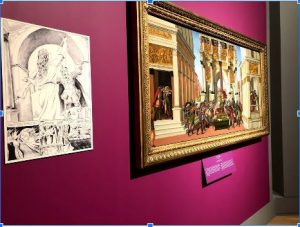by Hannah Elder
 The Isabella Stewart Gardner Museum was created as the vision of its founder and namesake. Isabella Stewart Gardner created the museum as an aesthetic space, surrounding visitors with beauty and inviting them to think about the ways different arrangements of objects and art made them feel. Although she often rearranged the art in the museum, she wanted her vision to be preserved, and wrote a clause into her will that effectively prevented the rearrangement of the collection. For many years, this restriction limited the museum’s exhibition program, but in 2012, the Gardner opened a new wing of the museum, designed by architect Renzo Piano. In this space, the Gardner has been able to use items in its collection in new ways, bringing them out of the context of Mrs. Gardner’s arrangements and bringing new perspectives to them.
The Isabella Stewart Gardner Museum was created as the vision of its founder and namesake. Isabella Stewart Gardner created the museum as an aesthetic space, surrounding visitors with beauty and inviting them to think about the ways different arrangements of objects and art made them feel. Although she often rearranged the art in the museum, she wanted her vision to be preserved, and wrote a clause into her will that effectively prevented the rearrangement of the collection. For many years, this restriction limited the museum’s exhibition program, but in 2012, the Gardner opened a new wing of the museum, designed by architect Renzo Piano. In this space, the Gardner has been able to use items in its collection in new ways, bringing them out of the context of Mrs. Gardner’s arrangements and bringing new perspectives to them.
The museum’s latest exhibition, Botticelli: Heroines + Heroes, uses contemporary cartoons to interpret Renaissance depictions of ancient Roman stories and brings those stories to a modern audience. The center of the exhibition is a pair of paintings by Renaissance artist Sandro Botticelli: the Story of Lucretia and the Story of Virginia. They depict the stories of two women whose deaths brought about political change in ancient Rome. They were painted as a pair, but are now in separate collections; the Gardner owns Lucretia, while Accademia Carrara in Bergamo, Italy owns Virginia. This exhibit is the first time they have been reunited. In the exhibit, the Gardner pairs the paintings with cartoons it commissioned from Boston-based graphic artist Karl Stevens.
One set of cartoons tells the story of how Mrs. Gardner acquired the Story of Lucretia. They are the first pieces of art the visitors encounter and help establish the importance of Botticelli’s work. The rest of the cartoons highlight the paintings’ relevance in the modern world, both stylistically and in terms of content. When the paintings and cartoons are placed side-by-side, it’s easy to see how Botticelli’s bold lines and bright colors relate to the work of today’s graphic artists. The cartoons also draw the viewers’ focus back to the women at the center of the stories. While looking at Botticelli’s work, where there are several scenes of a story in a single panel, the modern viewer can lose sight of the women’s central roles. The cartoons focus on the women and their experiences and are easier for the modern audience to understand. While it’s not clear whether the exhibit was originally designed with the intention of connecting the museum’s collection to the #MeToo era, the cartoons make the connection clear. The combination of the original paintings and the cartoons invite the viewer to contemplate the role that violence against women has played in politics and major events throughout history.
The museum is using a few methods to advertise the exhibition. They often use ads on public transportation, like the sides of buses and posters on the T, to promote the museum, and they used them for this exhibition. They are also using sponsored content on social media, probably with the goal of reaching people outside of the Boston area who appreciate art and museums. They also feature the exhibit in their non-sponsored content, including frequent posts and an opportunity to have questions about the exhibit answered in the Stories feature of the museum’s Instagram account. The exhibition was also featured in many publications, including Forbes, The Boston Globe, and Architectural Digest.
In addition to the exhibition itself, the museum scheduled a variety of programs to compliment it. They included a staged reading of an opera about the lives of Virginia and Lucretia and talks on violence in Renaissance art, the art of Botticelli, and connections between the art and today’s social activism. The events appear to be successful; two of the three upcoming events are sold out and there was high attendance at the opera.
Botticelli: Heroines + Heroes brings the collection of the Gardner museum into the modern world, exploring themes relevant to today and across time. The exhibition is open through May 19, 2019. For more information, visit https://www.gardnermuseum.org/calendar/exhibition/botticelli-heroines-heroes.
